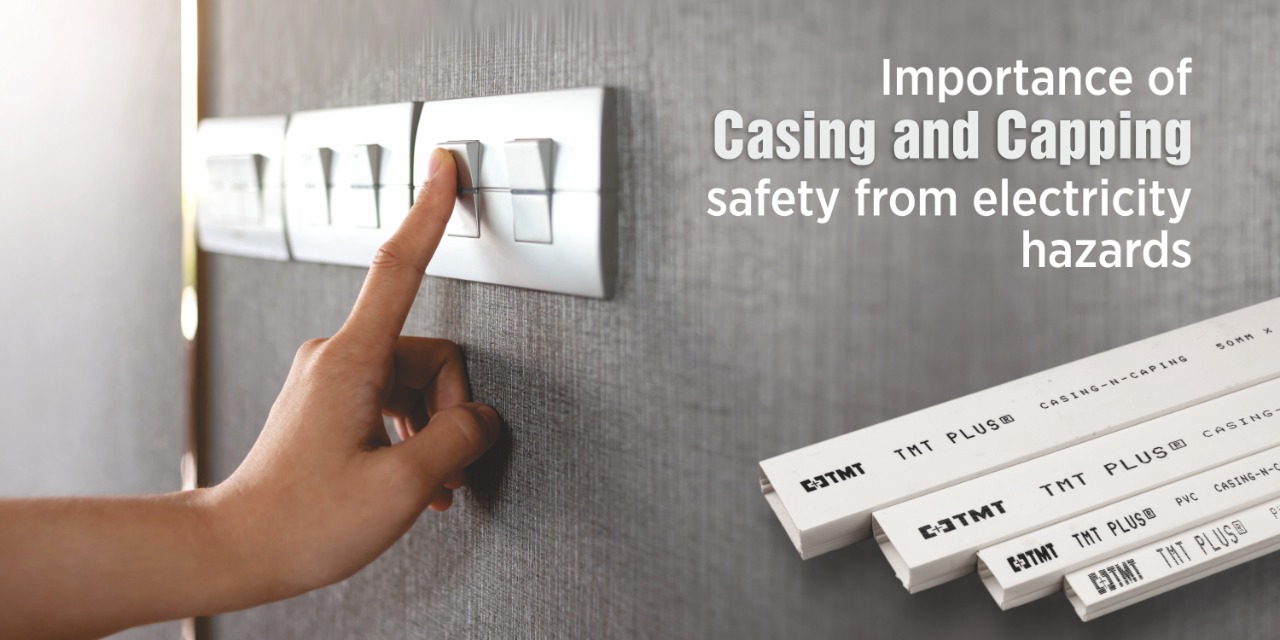
Despite being one of the oldest methods of wiring, casing capping is still used extensively today. This form of wiring is one of the most fundamental. Putting PVC-insulated wire in a plastic container and then capping the whole thing is what is meant by the term "casing capping." All of TMT Plus' Casing & Capping products are designed to keep your interiors looking their best while still adhering to electrical safety rules; that is why it is known to be the best Electrical Casing and Capping Manufacturer in Haryana. Wires are routed via grooves in a rectangular strip that serves as the casing.
Casing capping is a fundamental sort of electric wire arrangement. Various shapes and sizes of moulded domes are utilised to cover the wires. Aside from serving as a means of concealing wires, these covers also serve as a design feature to help the exposed circuit seem tidy.
White or grey are the most common colours for it and most Casing and Capping Suppliers in Himachal Pradesh have such colours. Electric wire systems typically have a case and cap diameter of 1.5 inches and a thickness of 0.8 inches. A 20-year lifespan is expected for the casing and capping wiring system. Due to its twofold insulation qualities, encased wire is the most often utilised wiring method in industrial environments. Casing and capping electrical systems may be installed either horizontally or vertically. T-Joint, L-Joint, and Bridge Joint are some of the joints that may be used in a wire system.
Compared to other kinds of wire systems, this one is a lot less costly to implement. They claim that it can withstand moisture as well as smoke. Customization is encouraged as a result. It's reasonable to assume that the risk of electric shock will be reduced. To make repairs simpler, the phase and neutral wires should be placed in separate slots.
Enclosing capping wiring is also known as 'Cable Trunking.' Casing Patti is another name for these wire covers in India. Installing them is a breeze, and they're available in a wide range of colours and trunk designs. Because of their plumbing size, however, they may be utilised in industrial settings as well as residential ones.
When dealing with complex wire installations Best quality 25mm casing capping in north India, is an essential tool. However, you must choose a certain design of trunk casing and capping based on your needs. As a result, we'll cover this procedure in more detail in the section on different types of casing and capping wire.
Wires for capping and casing are available in a wide range of styles.
It is possible to choose from four types of wire capping and casing:
Fit and press:
Press and fit is the most frequent way of wiring, in which one part is placed on the bottom surface and the other on top. The process of setting up the software is rather straightforward. First, the bottom part is attached to the walls. The wire is then fed down, and the cover is finally pressed into place at the bottom of the device.
Sliding and Fitting:
The sliding and fitting of the former design are equivalent. It's more common with casings that are more difficult to press and fit the capping. PVC is a tough material to press, however sliding makes it much easier to apply.
Positioned with ropes and chains:
Street light installation projects often meet the use of trunked fit as an additional layer on subterranean power cables.
Grilling:
One of the most common and versatile ways to handle telephone cabling is using a grilled-fit casing and cap. For the most part, the casing and capping system goes together quickly and easily. Installing a 0.01-inch insulation between the wall and casing prevents wall humidity from causing damage to the casing. Grooves are then made in two- and three-way designs with a 14-inch-wide surface. Finally, the screws are drilled into the casing at an 11-inch spacing.
For the most part, the casing and capping system goes together quickly and easily. Installing a 0.01-inch insulation between the wall and casing prevents wall humidity from causing damage to the casing. Grooves are then made in two- and three-way designs with a 14-inch-wide surface. Finally, the screws are drilled into the casing at an 11-inch spacing.
Various types of joints are used to install the casing and capping wire system in either a vertical or horizontal fashion. Among the joints are T-joints, L-joints, and a bridge joint.

Advantages of Casing Capping System:
- No risk Mechanical shock.
- In this system, the alternation is feasible.
- This is a significantly more affordable method of wiring than using shielded or conduit wire.
- When compared to a steel conduit and sheeted wire system, it is less expensive.
- It is thought to be smoke, dampness, and humidity resistant.
- This system's installation may be customised extremely easy.
- Because all of the wires are covered, there is a lower chance of electric shock.
- This wiring technique is both inexpensive and long-lasting.
- Oil, steam, smoke, and rain do not harm it.
- Repairing is simple if the phase and neutral wires are put in separate slots.
- Because of the sturdy casing and capping installation, you may stay in the field for a long period.
- This wiring system is very durable and long-lasting.
- When the phase and neutral wires are put in separate slots, repair becomes much easier.
Check out the casing & capping brand in North India -TMT Plus
Using the most up-to-date machinery, TMT plus manufactures only the highest-quality products for their customers. TMT Plus is committed to continual improvement, which is why they use the most up-to-date production methods to keep the prices of the products low. In accordance with government regulations, the manufacturing processes have been verified as ecologically friendly. TMT Plus aims to satisfy their customers by offering goods and services that are both high-quality and reasonably priced.
What makes TMT plus casing and capping a high quality casing and capping wire for electrical:
- It has two locking mechanisms.
- Heat Resistant Lightweight
- Installation in a flash
- Longevity
- Corrosive-free
- High Impact Resistance
Applications
- In residential, commercial, and industrial buildings, there is open wiring.
- In the sleevings and fake ceiling
- Wiring and terminals for telecommunications, for example
- Networking and LAN cabling
